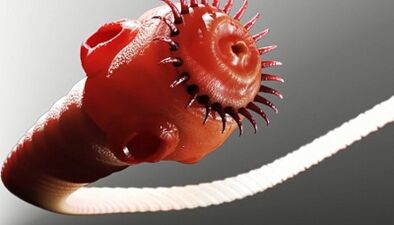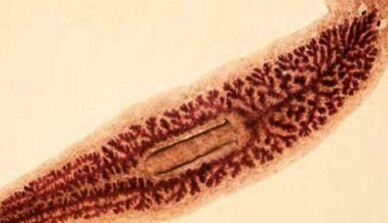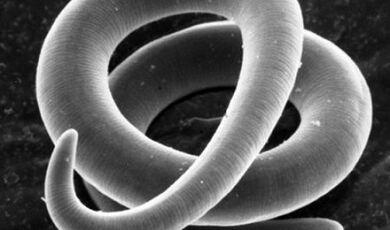
Even the development of technologies and household chemicals with an assortment of detergents does not rid our society of parasitic infestation.The number one reason is dirty hands.
There are types of worms that are not dangerous for humans and can be removed from the body without much difficulty.However, parasitologists also know those who kill their prey.
What worms can live in us?
Helminths can inhabit both animal and human bodies.It is not for nothing that they are called parasites, because they feed on the resources of the body they infect.And worms harm not only by eating food that we should eat, but also disrupt the normal functioning of the liver, heart, lungs and other organs.There are known cases of their penetration into the hearing aid, eyes and brain.
Experts divided those who most often come as uninvited "guests" into three groups.These types of parasites have become champions in terms of the number of infected, as more than 70% of recorded cases of infection belong to them.
Here is their brief description:
- Roundwormsthey combine pinworms, roundworms and so-called dogworms (another name is toxocara).
- Protozoan parasites.These include lamblia, amoebae, toxoplasmosis and malarial plasmodia.
- Flatworms.This class includes echinococcus, tapeworm (diffilobotryosis) and bovine tapeworm.
The cause of helminthiasis (helminthic infection) can be any of 150 types of parasitic creatures.Scientists have discovered many more of them;science knows 12,000 species of helminths.Next, let's consider which worms live in the human body.
The most common types are:
- Pinworms.Very small white worms that live and reproduce in the gastrointestinal tract of their prey.This type of worm causes the most damage because it disrupts the microflora of the intestinal tract.This negative influence causes subsequent diseases of the genitourinary system, enterobia, disorders of the nervous system, retardation in physical growth and mental development.The main routes of human infection are dirty hands, unwashed food and pets.
- Roundworms.These worms, which develop in the human body, sometimes reach 0.4 meters in length.Ascaris can move to the lung area from its permanent habitat, the intestinal tract.During the journey, the worm damages the tissues, which leads to bleeding in them.When the larvae are coughed up from the upper respiratory tract, they enter the oral cavity and are swallowed into the digestive system.An outside observer confuses this type of cough with a cold.They also harm by poisoning the microflora of the intestinal tract with toxins.In return, they feed on useful substances meant for us.Poisoning the body leads to allergies, as well as asthma attacks and suffocation.Dirty hands are the favorite transport of roundworms during the transition to a new body.
- Whipworm.In terms of the number of infected people, it takes a well-deserved third place.This worm enters the body of a new victim through poorly processed food.It causes the disease trichuriasis.The patient loses his appetite and complains of abdominal pain, anemia and diarrhea.External manifestations of the disease cannot be immediately distinguished from an attack of appendicitis.
- Wide band.In a sense, this worm claims to be the champion in length, as it sometimes reaches 10 meters and more.But there are more true parasites.It lives by eating freshwater fish.The worm sucks from the "owner" everything that should strengthen and nourish the person himself.It is not selective in damaging organs and can harm anyone.Signs of infection with this worm are headache and hallucinations (if it penetrates the brain), nausea and vomiting.In their action, and partly also in appearance, they are similar to pig and ox tapeworms, but they are longer than this worm.
- Hookwormsthey do not penetrate through food and the oral cavity.Their way of entry is different because they infect us through the skin.Living in contaminated soil, they seem to await human contact.Their harm lies in the fact that hookworms damage the intestines and lungs, and they also feed on blood.Symptoms are associated with abdominal pain and problems with the functioning of the esophagus.
- Trichinella.Helminthic infestation occurs when eating meat (especially game).Their presence in the body gives the following external manifestations:
- abdominal pain;
- itching;
- high temperature (after two weeks of stay);
- intestinal disorders;
- skin rash.
- Liver flukeit settles in a person by eating fish that has previously been affected by it.This worm causes damage to the gallbladder and intestines.Signs of flu infection: allergies and nausea, abdominal pain and cramps, joint pain and high fever.If the disease has become chronic, the next stage may be hepatitis.The more dire consequences of liver fluke infestation are cirrhosis and cancer.If this helminth is destroyed and removed, the damage it causes will be quite noticeable, leaving inflammation of the liver.
- Echinococcus.Tapeworms are also quite long and grow up to 5 meters.They lead a parasitic life on dogs, wolves and cats.When a person comes into contact with them, the worms first damage the intestines and then migrate throughout the body.The most favorite places for their settlement are the liver and lungs.The places where they are found are misdiagnosed as a cancerous tumor or cyst.Some doctors use the term "cyst" because it looks like a growth and reaches a very large size.When the imaginary tumor bursts, its contents acutely poison the entire human body.
Important.Worms of this species damage muscle tissue on a person's limbs and face, damage the respiratory system and even the heart, which leads to death.

People sometimes ignore helminthic infestation as an unpleasant, but quite easily tolerated disease.Accordingly, their beliefs do not encourage them to be extremely careful when they come into contact with any kind of dirt, poorly processed food, or contact with pets.
Such criminal negligence has its sad consequences.Worms are capable of killing their prey, apart from pain and organ damage.The most dangerous are helminths that feed on blood and useful substances inside people.
The differences between parasitic worms and each other lie in the degree of damage caused and the way they penetrate into the body of the new "host".Echinococci are known to form cysts, bovine tapeworms damage the intestines, and opisthorchis constantly eats the liver.Every day she is missing a certain number of cells.
Parasites from the class of protozoa reproduce very quickly when the right conditions are created for it.Giardia seems to be hidden for a while and has no manifestations.Toxoplasma hits a person in the head, hits his brain, which affects the victim's behavior.
Plasmodium malaria destroys blood cells and can lead to the death of the victim.
Consequences of infection:
- development of malignant tumors;
- immunity weakens;
- Metabolism is disturbed.
Mainly, helminths live in the intestinal tract, liver and lungs.Some cases indicate damage to muscle tissue, joints, eyes and brain.Thanks to blood flow, parasites are able to migrate throughout the body, causing problems wherever they appear.
Symptoms of the presence of parasites
Manifestations of helminthic infestation are very different from each other.But they also have common symptoms:

- muscle pain that weakens and swells;
- joints hurt, although they were not injured;
- the liver and spleen increase in size;
- skin rash;
- high temperature.
You can add to them:
- itching near the anus, abdominal pain, gastrointestinal tract disorder, constipation, vomiting, diarrhea and flatulence, perhaps even intestinal obstruction, the person is weak and complains of anemia;
- intoxication with parasite secretions disrupts the work of the nervous system, which leads to headaches, dizziness and nausea.Since parasites eat substances intended to strengthen a person, the body weakens and constantly feels drowsy, fatigue for no reason, disturbed sleep and it is difficult even to do serious mental work;
- itching and allergies on the skin, urticaria, hair and nails become brittle, signs of bronchial asthma, rhinitis and dry cough;
- weakened immunity allows access to various types of infections, inflammations in the mouth and nose cause stomatitis, sinusitis and sinusitis;
- Women develop appendicitis and fish-smelling discharge (bacterial vaginosis).
Worms sometimes bring the body of an infected person to such a state that a full-fledged healthy life, even after their removal, is no longer possible.Therefore, if you discover any of the symptoms, consult a doctor immediately.
Photos of worms that can live inside you
Worms of different types, sizes and shapes can inhabit the human body.They use any method of migration to live at the expense of others.It is believed that 4/5 of the population of our planet has a helminthic infestation and carries various parasites.A person may not realize that he is not the only one who eats food, but also a "resident" in the intestines.
The symptoms of their presence are not immediate and not clearly expressed in everyone.A long stay of worms will lead the body to chronic diseases.Many diseases are believed to start with worms.Before starting treatment, you should first recognize your inner enemy so that you don't fight blindly.
Worms that inhabit humans are divided into types:
- round worms;
- tapeworms;
- flukes.
Even looking at a photo of a parasite is not a very pleasant experience, but carrying it around is much worse.People think that someone else might have an infestation, but it won't affect me.What a shock it is when they learn that a monster has come and taken up residence in their own body!

Thanks to such materials, smart people are better prepared to protect themselves and their loved ones.But no one alone should do anything in destroying uninvited "guests".
If the parasites are different, the treatment is not always the same.They do not give the same pill for lice and roundworms;there are significant differences in lifestyle, place of settlement and mode of infection.First, the type of helminth and the direction of its harmful effects are determined, and only then the doctor selects the drug, taking into account the age and other health characteristics of each patient.
So, having received a sufficient amount of information about the types of worms, symptoms and degree of damage, the reader can undergo a diagnosis and pass the appropriate tests, which will be prescribed by a parasitologist.Not all worms are equally dangerous, but any of their species poisons the body with the waste products of their vital activity, and each feeds on something of ours: food or body tissue.
FYI.The term "parasite" comes from the Greek word for parasite.Two or more organisms live side by side, but one "sits on the neck" of the other, feeding and reproducing at the expense of the others.The digestive system can also contain multicellular helminths and protozoa.Tapeworms, roundworms and pinworms are quite common.They have a relatively complex body structure.
The vast majority of helminths negatively affect the general well-being and health of a person, causing the development of very serious diseases.With this in mind, when the first signs of the disease appear that do not pass the treatment of a cold or a skin rash with a headache, it is necessary to consult a doctor for a diagnosis.
Today, doctors have enough methods and highly accurate technologies to confirm or refute suspicions of parasitic worm infection.If helminths are detected, only a specialist can choose the most optimal method of treatment.
How to prevent helminthic infestation?Should you constantly limit yourself to one or another vacation, literally "squeezing" your life in vice by observing complex postulates?
In fact, infection with intestinal parasites and subsequent treatment can be avoided if you follow very simple rules:
- wash your hands only with soap;
- drink filtered water;
- Fruits and vegetables should not only be washed with water, but it is better to pour boiling water over them;
- do not allow swimming in polluted waters;
- meat and fish products must undergo mandatory heat treatment;
- children's toys used outside are disinfected;
- Vaccinate pets against parasites.
Conclusion
But everyone should start from themselves, because all modern achievements mean nothing if you simply ignore personal hygiene and preventive measures for those family members who live in our home.Taking care of your health, detecting it in time (if there is an infection), starting treatment competently and on time - all this will help prevent a major disaster on a personal level and the spread of the disease in your environment.
It is much easier to prevent parasitic worms than to experience ill health, all kinds of disorders and fever, and then still have to follow the rules.It's just that it's no longer a hygiene course, but treatment, diet and immune restoration.And it's good if there's no surgery.Take care, it's easier.



























